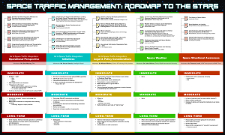Advanced Debris Analysis Techniques Enabled by Rich Persistent Datasets
Abstract
Recent events in Geosynchronous Earth Orbit (GEO), including two probable breakup events in summer 2017, illustrate the potential risks of hazardous debris on orbit. Historically, distinguishing among the many types of negative events that may befall a satellite on orbit (and which may all be grouped together under the category of anomalies) has been challenging, due to a lack of observation data of sufficient volume and quality to support analyses capable of disambiguating these occurrences. As a result, there is limited opportunity to examine these incidents and extract lessons that may support future space traffic management objectives.
However, the events of summer 2017 provided extensive data to multiple observers, including the ExoAnalytic Global Telescope Network (EGTN). The significant volume of collected imagery and derived products can be used to interrogate the events in depth and potentially to ascertain future methods of mitigating the relevant risks. In both cases, staring sensors were pointed at the objects, and thousands of frames were collected during the immediate period surrounding the two very different events. Because the sensors used were persistent, there was a stream of relevant data bracketing the time of interest. Because the data collection architecture used captures and stores raw imagery at large scales, the data stream was rich enough to support primary analysis of astrometric and photometric data as well as secondary analysis of the child objects, including attempts to account for impact and kinetic energy conserved through the event. Additionally, because the sensors were elements of a global network, there was an existing detailed pattern of life for the objects, and data from before the breakup was available for comparison, and deviations were notable on an almost real-time basis.
Taken together, these facts show the importance of a robust persistent SSA sensor network, and how to utilize the data to develop advanced alerts for other satellites operating nearby. This paper describes the data collected, explains the analyses performed and others that may be possible with additional advancement, and uses the two events as case studies for the future.
Advanced Debris Analysis Techniques Enabled by Rich Persistent Datasets
Henderson Welcome Center
Recent events in Geosynchronous Earth Orbit (GEO), including two probable breakup events in summer 2017, illustrate the potential risks of hazardous debris on orbit. Historically, distinguishing among the many types of negative events that may befall a satellite on orbit (and which may all be grouped together under the category of anomalies) has been challenging, due to a lack of observation data of sufficient volume and quality to support analyses capable of disambiguating these occurrences. As a result, there is limited opportunity to examine these incidents and extract lessons that may support future space traffic management objectives.
However, the events of summer 2017 provided extensive data to multiple observers, including the ExoAnalytic Global Telescope Network (EGTN). The significant volume of collected imagery and derived products can be used to interrogate the events in depth and potentially to ascertain future methods of mitigating the relevant risks. In both cases, staring sensors were pointed at the objects, and thousands of frames were collected during the immediate period surrounding the two very different events. Because the sensors used were persistent, there was a stream of relevant data bracketing the time of interest. Because the data collection architecture used captures and stores raw imagery at large scales, the data stream was rich enough to support primary analysis of astrometric and photometric data as well as secondary analysis of the child objects, including attempts to account for impact and kinetic energy conserved through the event. Additionally, because the sensors were elements of a global network, there was an existing detailed pattern of life for the objects, and data from before the breakup was available for comparison, and deviations were notable on an almost real-time basis.
Taken together, these facts show the importance of a robust persistent SSA sensor network, and how to utilize the data to develop advanced alerts for other satellites operating nearby. This paper describes the data collected, explains the analyses performed and others that may be possible with additional advancement, and uses the two events as case studies for the future.

